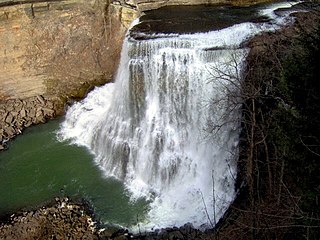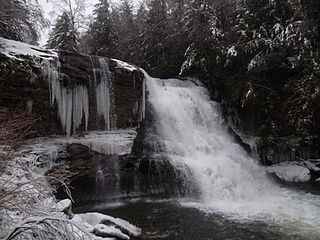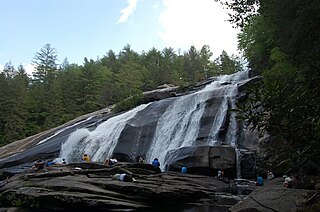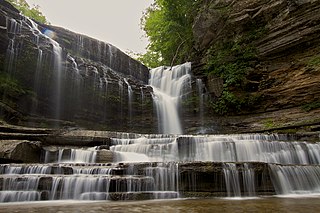Related Research Articles
Protected areas of Tasmania consist of protected areas located within Tasmania and its immediate onshore waters, including Macquarie Island. It includes areas of crown land managed by Tasmanian Government agencies as well as private reserves. As of 2016, 52% of Tasmania's land area has some form of reservation classification, the majority is managed by the Tasmania Parks & Wildlife Service. Marine protected areas cover about 7.9% of state waters.

Fall Creek Falls State Resort Park is a state park in Van Buren and Bledsoe counties, in the U.S. state of Tennessee. The over 30,638-acre (123.99 km2) park is centered on the upper Cane Creek Gorge, an area known for its unique geological formations and scenic waterfalls. The park's namesake is the 256-foot (78 m) Fall Creek Falls, the highest free-fall waterfall east of the Mississippi River.

Burgess Falls State Park is a state park and state natural area in Putnam County and White County, Tennessee, located in the southeastern United States. The park is situated around a steep gorge in which the Falling Water River drops 250 feet (76 m) in elevation in less than a mile, culminating in a 136-foot (41 m) cataract waterfall.
The Wolf River Conservancy (WRC) is a non-profit 501(c)(3) organization whose stated purpose is "conserving and enhancing the Wolf River and its environs as a natural resource for public education and low-impact recreational activities." Headquartered in Memphis, Tennessee. It has approximately 1,500 members from throughout West Tennessee, led by an active Board of Directors and staff and advised by the Wolf River Conservancy Trustees. It is a fully accredited member of The Land Trust Alliance.

Swallow Falls State Park is a public recreation area located on the west bank of the Youghiogheny River nine miles (14 km) northwest of Oakland in Garrett County, Maryland, in the United States. The state park features Maryland's highest free-falling waterfall, the 53-foot (16 m) Muddy Creek Falls, as well as smaller waterfalls on the Youghiogheny River and Tolivar Creek. The park is notable for its stand of old hemlock trees, some more than 300 years old, "the last stand of its kind in Maryland."

DuPont State Recreational Forest, commonly known as DuPont Forest, is a 12,500-acre (51 km2) state forest, located in Henderson and Transylvania counties of North Carolina. The name originates from the fact that the DuPont company arranged the sale of the original tract to the state. Adjacent tracts have since been purchased and added to the state forest. Portions of the forest formerly contained a manufacturing facility for the production of X-ray film. The forest was used to shoot scenes from the 1992 film The Last of the Mohicans as well as the 2012 box office hit The Hunger Games. On February 12, 2019, the forest added 402 acres (1.63 km2) from Conserving Carolina, part of a section called the Continental Divide Tract that connects with other public lands. 314 more acres was added to the forest in 2019.
Natural Lands is a non-profit land conservation organization with headquarters in Media, Pennsylvania, dedicated to the management, protection, and conservation of eastern Pennsylvania and southern New Jersey's native forests, fields, streams, and wetlands. The organization owns and manages 43 nature preserves—and one public garden totaling more than 23,000 acres—located in 13 counties in Pennsylvania and New Jersey. Nineteen of the preserves are open to the public for recreational use; the others have limited visitation due to the presence of sensitive ecosystems or limited facilities.

Stillhouse Hollow Falls State Natural Area, located in Summertown, is a natural area in Maury County, Tennessee. The main feature of the area is Stillhouse Hollow Falls, a 75-foot (23 m) waterfall, which is located approximately two-thirds of a mile from the entrance. The natural area was acquired by the Tennessee Parks and Greenways Foundation (TPGF) and was later sold to the state of Tennessee. It was designated a natural area on June 3, 2006, under the Natural Areas Preservation Act of 1971.

Scott's Gulf is a canyon situated along the Caney Fork River in White County, Tennessee, in the southeastern United States. The canyon stretches for approximately 18 miles (29 km) as the Caney Fork drops from the top of the Cumberland Plateau down to the eastern Highland Rim. This remote section of the river is home to a wilderness area consisting of a largely undisturbed deciduous forest, numerous waterfalls, caves and other geological formations, and Class IV and Class V whitewater rapids.

Ozone Falls State Natural Area is a state natural area in Cumberland County, Tennessee in the southeastern United States. It consists of 43 acres (0.17 km2) centered on Ozone Falls, a 110-foot (34 m) plunge waterfall, and its immediate gorge along Fall Creek. Because of its picturesque beauty and easy access, Disney selected Ozone Falls for scenes for their live-action film "Rudyard Kipling's The Jungle Book". The area is managed by the Tennessee Department of Environment and Conservation and maintained by Cumberland Mountain State Park. It is also part of Cumberland Trail State Park.
The Blue Ridge Land Conservancy (BRLC), formerly known as the Western Virginia Land Trust (WVLT), is a non-profit land trust and conservation organization headquartered in Roanoke, Virginia that seeks to preserve the wilderness and farmlands in the western portion of the Commonwealth of Virginia from excessive commercial development. BRLC's service area contains ten counties: Bedford, Botetourt, Craig, Floyd, Franklin, Montgomery, and Roanoke.
Conserving Carolina is a non-profit conservation organization working to preserve water and land resources in Western North Carolina. Conserving Carolina was created in July 2017, from a merger of two previously separate organizations, Carolina Mountain Land Conservancy and Pacolet Area Conservancy. The combined organization maintains a primary office in Hendersonville, NC and a regional office in Columbus, NC.
Joshua's Tract Conservation and Historic Trust, or Joshua's Trust, is a non-profit 501(c)(3) land trust operating in northeast Connecticut. Joshua's Trust was incorporated in 1966 to help conserve property of significant natural or historic interest. As of 2011, the Trust protects more than 5,000 acres, maintains 42 miles of trails that are open to the public, holds educational outreach programs, and publishes the Joshua's Tract Walkbook.
The Window Cliffs State Natural Area covers 275 acres (111 ha) in Putnam County, Tennessee, near Cookeville. The Window Cliffs is the name of a prominent group of natural bridges in a narrow 200-foot-tall (61 m) ridge in the neck of a meander of Cane Creek. The day-use area is only accessible by hiking a 2.7 miles (4.3 km) trail. The Window Cliffs was an acclaimed destination in the nineteenth and early twentieth centuries. The area contains several state-listed endangered plants.

Cummins Falls is a waterfall on the Blackburn Fork River and is located in southern Jackson County, Tennessee. By volume, it is the eighth largest waterfall in Tennessee. The falls, with a total height of seventy-five feet, consist of two drops. The first has a plunge drop of fifty feet, ending in a shallow pool. The second has a cascade drop of twenty-five feet into a larger, deeper pool, or "swimming hole". In 2010, Cummins Falls was named "Tenth Best Swimming Hole in America" by Travel + Leisure magazine.
Openlands is a non-profit conservation organization and accredited land trust that works with groups and individuals in northeastern Illinois, northwestern Indiana, and southeastern Wisconsin to preserve open space, develop walking and biking trails, restore natural areas, and connect people to the outdoors. Openlands has protected and expanded public access to more than 55,000 acres of land for parks, forest preserves, land and water greenway corridors, and urban gardens across the Chicago metropolitan region. It is a member of Chicago Wilderness.

Cummins Falls State Park is a 282-acre (1.14 km2) state park located northwest of Cookeville in Jackson County in the U.S. state of Tennessee. Its namesake, Cummins Falls, is a 75-foot (23 m) waterfall, which is located on the Blackburn Fork State Scenic River. The park was purchased and created by the Tennessee Parks and Greenways Foundation in 2011.
The Land Trust for Tennessee is an non-profit conservation organization working to protect Tennessee's natural, scenic, and historic landscapes and sites. Since 1999, The Land Trust has conserved more than 135,000 acres (550 km2) of land across 65-plus Tennessee counties.

The Big Sur Land Trust is a private 501(c)(3) non-profit located in Monterey, California, that has played an instrumental role in preserving land in California's Big Sur and Central Coast regions. The trust was the first to conceive of and use the "conservation buyer" method in 1989 by partnering with government and developers to offer tax benefits as an inducement to sell land at below-market rates. Since 1978, with the support of donors, funders and partners, it has conserved over 40,000 acres through conservation easements, acquisition and transfer of land to state, county and city agencies. It has placed conservation easements on 7,000 acres and has retained ownership of over 4,000 acres.
The Tennessee River Gorge Trust is a non-profit land trust conservation group acquiring and maintaining conservation areas, building trails, and conducting environmental studies and education programs in the Tennessee River Gorge near Chattanooga, Tennessee. It is involved in preserving natural areas along the Tennessee River. The group was established in 1981.
References
- ↑ "TennGreen Land Conservancy - American Trails". www.americantrails.org. Retrieved 2021-12-07.
- ↑ "TennGreen - Land Trust - Protecting Tennessee's natural treasures". tenngreen.org. Retrieved 16 February 2017.
- ↑ "Nearly Three Dozen More Land Trusts Achieve Accreditation". landtrustalliance.org. 5 August 2015. Retrieved 16 February 2017.
- ↑ "Accredited Land Trusts" (PDF). Land Trust Accreditation Commission. 2015. Retrieved 16 February 2017.
- ↑ Williams, Kathleen (24 May 2016). "Tennessee needs greater emphasis on conservation". The Tennessean. Retrieved 16 February 2017.
- ↑ Paine, Anne (14 January 2007). "Treasured land is protected" (PDF). The Tennessean. Retrieved 16 February 2017.
- ↑ "Stillhouse Hollow Falls Class I Scenic-Recreational State Natural Area". tennessee.gov. Retrieved 16 February 2017.
- ↑ Drake Silence, Sherri (20 November 2008). "Tennessee Parks and Greenways Foundation dedicates Randolph Bluff Historic Park in Tipton County : Millington Tipton". Memphis Commercial Appeal. Archived from the original on 20 November 2008. Retrieved 16 February 2017.
- ↑ Charlier, Tom (25 July 2010). "Good looks: Conservation efforts making a scene of Mississippi's bluff-top vistas". Memphis Commercial Appeal. Archived from the original on 28 July 2010. Retrieved 16 February 2017.
- ↑ Wilson, Jessica (31 August 2010). "Southern Wanderings". southernwanderings.com. Retrieved 16 February 2017.
- ↑ "Cummins Falls State Park". Tennessee State Parks. Retrieved 16 February 2017.
- ↑ Bruneau, Alice. "Cummins Falls, Cookeville, TN". Travel + Leisure. Retrieved 16 February 2017.
- ↑ "Big Swan Headwaters conserved for future generations". Herald Chronicle. Summertown, TN: Lakeway Publishers, Inc. 31 May 2017. Retrieved 3 June 2017.
- 1 2 Nelson, Gary. "TennGreen protects 956 acres of Grassy Cove". Crossville Chronicle. Retrieved 2020-03-31.